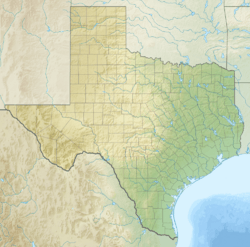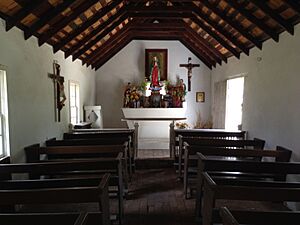La Lomita Chapel facts for kids
Quick facts for kids |
|
|
La Lomita Chapel
|
|

La Lomita Chapel in 2014
|
|
| Location | 3 miles south of Expressway 83 on FM 1016, Mission, TX 78572 |
|---|---|
| Built | 1865, 1899 |
| NRHP reference No. | 75002165 |
La Lomita Chapel is a historic Catholic church located in Mission, Texas. It was once a very important place for the Cavalry of Christ. This was a group of priests who rode horses for long distances. They visited Catholic families living on lonely ranches along the Rio Grande river.
In 2018, the chapel became part of a disagreement between the United States government and the Catholic Church. The government wanted to use the chapel's land for a border wall between the U.S. and Mexico. However, in 2019, the U.S. Congress stopped this plan with a special budget rule.
About the Chapel
The chapel is built from white adobe, which is a type of sun-dried brick. It is located very close to the Rio Grande river.
History of La Lomita
The area was first called La Lomita, meaning "the little hill." A rancher named José Antonio Cantu received this land from Spain in 1770. Later, in 1851, a French merchant named René Guyard bought the land. He was a very religious Catholic. Guyard built the first chapel in 1865.
In 1871, Guyard gave the chapel to the Missionary Oblates of Mary Immaculate. La Lomita was located between other important missions in Brownsville and Roma. This made it a key stopping point for the Cavalry of Christ. The chapel served about 65 ranches in the area. Traveling missionaries often rested there during their long journeys.
The area around the chapel grew into a small village. The Oblate Fathers built a rectory (a house for priests), a guest house, a blacksmith shop, and other buildings. After a big flood in 1899, the chapel was rebuilt using stones from nearby hills. When the city of Mission, Texas, was started in 1908, it was named in honor of La Lomita Chapel.
The chapel was recognized as a Recorded Texas Historic Landmark in 1964. It was also added to the National Register of Historic Places in 1975. In 2010, experts worked to restore the building. This project won an award and was featured in a magazine.
Professor Terry G. Jordan-Bychkov believes that a French-American priest and architect, Pierre Yves Kéralum, might have designed La Lomita chapel. He thinks Father Keralum had the skills and experience to create buildings like this in the region. Today, La Lomita is seen as a small, humble, and well-cared-for place. It reminds people of its important role in the area's history.
Disagreement Over the Border Wall
In October 2018, the United States Border Patrol started a legal case. They wanted to take the land around the chapel to build a border fence. The local pastor, Roy Snipes, and his bishop, Daniel E. Flores, did not agree with this plan. The Brownsville diocese tried to stop it in court.
In December 2018, a group from Georgetown University Law Center supported the diocese. The planned wall would have blocked access to the church. It would have put the chapel on the Mexican side of the fence. Bishop Flores said that building the wall went against Catholic beliefs about people getting along.
Many local people protested to support La Lomita. On Palm Sunday, April 14, 2019, over a thousand church members walked in a procession to the chapel. Pastor Roy Snipes was later nominated for an award for his efforts. Some groups who supported the wall criticized Snipes and the National Butterfly Center. This center also opposed the wall on its land.
At a court hearing in McAllen, Texas, on February 6, 2019, a judge said the diocese had to let surveyors onto the land. The diocese planned to use the Religious Freedom Restoration Act if the government still wanted the land. This law stops the government from making it very hard for people to practice their religion. An attorney for the diocese said that blocking access to the chapel would be a big problem for religious freedom.
In February 2019, Congress changed a spending bill. They added rules that stopped new money from being used to build border barriers at La Lomita. This also protected other places like the Santa Ana National Wildlife Refuge and the National Butterfly Center. However, soon after, President Trump declared a national emergency. His legal team said the new rules did not apply. This left the chapel's future uncertain.
On May 24, 2019, a judge temporarily stopped the government's plan to use money not approved by Congress. But on June 3, 2019, another judge did not stop spending on the wall.
Even though the budget deal protected the chapel from a physical wall, in May 2020, the U.S. Department of Homeland Security announced a "virtual wall." This would use technology to detect movement in the Rio Grande Valley. However, the department would still need permission from the chapel to put any equipment on its property.
More to Explore




